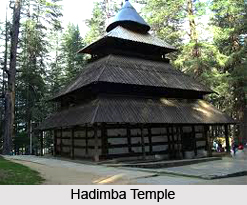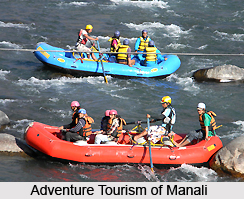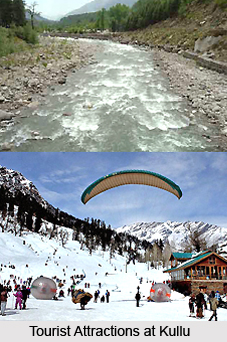There are a handful of interesting places in Manali, Himachal Pradesh, enough to mesmerize the minds of nature lovers and tourists. Manali, Himachal Pradesh, is called the valley of Gods with several temples strewn throughout the place.
 Hadimba temple: Also known as Dhoongri temple, this temple becomes the chief attraction of Manali. It is built in commemoration of deity Hadimba , wife of Bhim , the famous Pandava prince. It was constructed as early as 1533 AD. The architectural design of the temple also has caught attraction of the people. It has got 4 -tiered roof made in the shape of a Pagoda . Legendary figures and symbols embellished its entrance. In the backdrop the beauty of wooden forests thronged with deodhar trees also can fascinate any one. This temple is in the midst of this forest and almost `2.5 kms from the tourist office`. Every year during the month of May, a pompous festival use to be organized where the local people take part in great delight.
Hadimba temple: Also known as Dhoongri temple, this temple becomes the chief attraction of Manali. It is built in commemoration of deity Hadimba , wife of Bhim , the famous Pandava prince. It was constructed as early as 1533 AD. The architectural design of the temple also has caught attraction of the people. It has got 4 -tiered roof made in the shape of a Pagoda . Legendary figures and symbols embellished its entrance. In the backdrop the beauty of wooden forests thronged with deodhar trees also can fascinate any one. This temple is in the midst of this forest and almost `2.5 kms from the tourist office`. Every year during the month of May, a pompous festival use to be organized where the local people take part in great delight.
Manu temple lies at a distance of near about three kms from the main market in Old Manali. This temple is dedicated to `Manu Rishi`. Legend says that it is the only temple in the whole of India, which has been devoted to Manu, who is believed to have created human kind on earth.
Club house: Club house is a place of attraction and it lies nearly two kms from the town . It is on the left bank of Manalsu Nallah. Special arrangements for playing indoor games are available. One also can visit some of the picnic spots, which have been built near by.
The trip to Manali, Himachal Pradesh would be incomplete unless and until one go and visit the Tibetan monasteries. They are constructed only recently and tourists mob the monasteries to buy decorative items like carpets and varied handworks of Tibet.
 Strategically, one temple is located within the town, while the remaining two are built on left bank of River Beas.
Strategically, one temple is located within the town, while the remaining two are built on left bank of River Beas.
Mountaineering institute: This institute provides an enthusiast with fundamental and advanced training courses and other facilities like trekking, mountain climbing, skiing and water games. It is situated almost three kms on the left bank of Beas river towards Kulu. In order to get equipments for skiing and trekking one needs to hire them from the institute. This is done through advance booking. There is also a beautiful showroom.
Vashist hot water springs and temple (3 Kms): Vashist, is a tiny village which tourists visit in large numbers. It has a plethora of temples, hot springs that made it a popular name amongst Manali tourists. It has its location on the River Beas`s left bank leading to Rohtang pass. In the close proximity there is also a wonderful pyramidal temple made of stone. It has been devoted to Vashist Muni. One also finds a beautiful temple, which is dedicated to Lord Rama. Natural hot sulphur springs also are unique. Any person can bask into fun of bathing. There are two individual tanks for both men and women. . Moreover stylish shower fitting baths built in the Turkish mode are built in the close locales. There also one can get the facility of getting hot water for bathing from the springs situated in and around.
Nehru kund is a landmark at Manali, Himachal Pradesh. Lying almost five kms on National Highway to Leh, it is the names of a natural spring of icy and clean water. It has derived its name from Pt. Jawahar Lal Nehru. The popular saying is that while staying in Manali, Himachal Pradseh PT. Nehru also drank water from the spring. Also a story is popular about the origination of Nehru Kund at Manali, Himachal Pradesh. It has its source in the Bhrigu Lake, which lies in the top of the mountains.
Beas Kund - Beas Kund is quite popular, whose source is at the Rohtang Pass. An interesting story is popular. It is believed that great rishi, Vyas executed "Tapa" during the days of Mahabharata.
 Solang valley: Lying between Solang village and Beas Kund, this spectacular Solang valley offers a panoramic view of bounty of Mother Nature like glaciers and snow capped mountains and peaks. From Manali, Himachal Pradesh stretches up to thirteen kms. It has fine ski slopes. The Mountaineering Institute has placed a special ski lift to cater to the needs of training and learning. Here in Solang Valley one can get training in skiing.
Solang valley: Lying between Solang village and Beas Kund, this spectacular Solang valley offers a panoramic view of bounty of Mother Nature like glaciers and snow capped mountains and peaks. From Manali, Himachal Pradesh stretches up to thirteen kms. It has fine ski slopes. The Mountaineering Institute has placed a special ski lift to cater to the needs of training and learning. Here in Solang Valley one can get training in skiing.
A hut and `guest house of the Mountaineering and Allied sports Institute, Manali` are found here. Over the years quite a few hotels also have been built. Also it is the venue for the winter skiing festival.
Kothi: Kothi is a wonderful tourist locale, which lies almost twelve kms from Manali, Himachal Pradesh. To be more specific, it is on the road that leads to Rohtang Pass. IT is ideal for shooting movies and also stimulates one to nurture the creative zeal. A PWD rest house and also a number of hotels are built to meet the increasing tourists, nature freaks.
Rahala waterfalls: It is situated almost sixteen kms on the way to Rohtang pass. From Kothi from the old road, strolling down Marhi enables one to come across a captivating water fall. The place has become ideal for picnicking.
Rohtang pass (3979 m): In Manali, Himachal Pradseh, Rohtang pass has become a major tourists attraction. It has its location on highway to Keylong/Leh. This pass is almost fifty-one kms away from Manali, Himachal Pradesh. It offers an eye-catching view of the place full with mountains and hills. The pass remains open from the month of June to October month. From middle of June one also can take the facility of buses, which travel regularly from Manali to places like Keylong/Darcha, Spiti and Leh, Udaipur. Its height is approximately 3979 above the mean sea level.

Trekkers however also can cross before that also. It acts an entrance to various places like Lahaul Spiti, Pangi and Leh valley.
Arjun gufa: Another spectacular site of Manali , Himachal Pradseh is Arjun Gufa. It is a cave, which lies almost four kms from Manali, Himachal Pradseh towards Naggar. Its is a part of Prini village almost one km above the road, where Pandava prince Arjun carried on with his meditation. Captivating view of snowy mountain ranges is a treat for the tourists who visit the place for excursion again and again.
Marrhi - It lies almost thirty-five kms from Manali, Himachal Pradseh widely noted for its nature`s glory.
Jagatsukh: This locale in Manali, Himachal Pradseh is popular for various ancient temples dedicated to Lord Shiva and Sandhya Gayatri. The later temple is constructed following the Shikhara style. It is placed almost six kms from Manali, Himachal Pradseh on the River Beas`s left bank on roadway to Naggar.
Naggar Fort is another attractive tourists destination in Manali, Himachal Pradesh. Lying south part of Manali it stands as an epitome of heritage of the golden past of almost 1500 years of Pal Dynasty. Constructed with stones, and intricate woodcuttings, it is a symbol of exquisite and graceful artistic works of the whole of Himachal region. In the later period, this fortress was transformed into a hotel and resting house which provides comforts and luxury to the lodgers. Lodgers also get mesmerized by the beauty of a tiny shrine, which is placed in the courtyard of the fort building. Truly it represents as the exquisite art and architecture of the then Pal Dynasty.
Sissu, Udaipur ,Triloknath, Baralacha Pass, Keylong, Tandi, Gondla ,Lahaul are some of the places of interests which are found in the vicinity. Manikaran is one such significant tourist locale. Manikaran is a pilgrimage hub for community people like Hindus and Sikhs. It lies almost eighty-five kms from Manali and also forty-five kms from Kullu. It is on the Parvati Valley. Unique is the presence of Parvati river water. Also there are hot water springs, which are noted for their medicinal values.



















